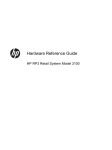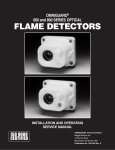Download HP RP2 Hardware Reference Manual
Transcript
Hardware Reference Guide HP RP2 Retail System © Copyright 2014 Hewlett-Packard Development Company, L.P. Microsoft and Windows are U.S. registered trademarks of the Microsoft group of companies. The information contained herein is subject to change without notice. The only warranties for HP products and services are set forth in the express warranty statements accompanying such products and services. Nothing herein should be construed as constituting an additional warranty. HP shall not be liable for technical or editorial errors or omissions contained herein. First Edition: April 2014 Document Part Number: 761488-001 Product notice Software terms This guide describes features that are common to most models. Some features may not be available on your computer. By installing, copying, downloading, or otherwise using any software product preinstalled on this computer, you agree to be bound by the terms of the HP End User License Agreement (EULA). If you do not accept these license terms, your sole remedy is to return the entire unused product (hardware and software) within 14 days for a refund subject to the refund policy of your place of purchase. Not all features are available in all editions of Windows 8. This computer may require upgraded and/or separately purchased hardware, drivers and/or software to take full advantage of Windows 8 functionality. See http://www.microsoft.com for details. This computer may require upgraded and/ or separately purchased hardware and/or a DVD drive to install the Windows 7 software and take full advantage of Windows 7 functionality. See http://windows.microsoft.com/en-us/ windows7/get-know-windows-7 for details. For any further information or to request a full refund of the computer, please contact your local point of sale (the seller). About This Book This guide provides basic information for upgrading this computer model. WARNING! Text set off in this manner indicates that failure to follow directions could result in bodily harm or loss of life. CAUTION: Text set off in this manner indicates that failure to follow directions could result in damage to equipment or loss of information. NOTE: Text set off in this manner provides important supplemental information. iii iv About This Book Table of contents 1 Product overview .............................................................................................................................................. 1 Product Models .................................................................................................................................... 1 Standard features ................................................................................................................................. 1 Rear components ................................................................................................................................. 3 Connecting a serial device ................................................................................................... 4 2 Hardware upgrades .......................................................................................................................................... 5 Tools needed ........................................................................................................................................ 5 Warnings and cautions ......................................................................................................................... 5 Mounting the RP2 to a wall, swing arm, or pole-mounted bracket ....................................................... 6 Unfolding the stand .............................................................................................................................. 7 Adjusting the tilt angle .......................................................................................................................... 7 Routing cables to external devices ....................................................................................................... 8 Replacing the power supply ............................................................................................................... 10 Installing optional HP integrated USB peripheral modules ................................................................. 13 Installing memory ............................................................................................................................... 17 DDR3-SDRAM SODIMM ................................................................................................... 17 Replacing the SODIMM ..................................................................................................... 17 Removing the front panel ................................................................................................................... 19 Replacing the front panel ................................................................................................................... 21 Replacing the hard drive .................................................................................................................... 23 Replacing the battery ......................................................................................................................... 26 Securing the RP2 to a counter top ..................................................................................................... 28 Installing an external security lock ...................................................................................................... 29 Cable lock .......................................................................................................................... 29 Padlock .............................................................................................................................. 30 3 Configuring the software ................................................................................................................................. 31 Touch screen calibration .................................................................................................................... 31 Calibration for Windows 7 Professional and Embedded POSReady 7 .............................. 31 Calibration for Windows 8.1 Professional and Embedded 8.1 Industry Pro Retail ............ 31 Configuring the MSR .......................................................................................................................... 31 Configuring powered serial ports ........................................................................................................ 32 Appendix A Troubleshooting .............................................................................................................................. 33 Interpreting POST diagnostic front panel LEDs and audible codes ................................................... 33 v Appendix B Electrostatic discharge ................................................................................................................... 36 Preventing electrostatic damage ........................................................................................................ 36 Grounding methods ............................................................................................................................ 36 Appendix C Computer operating guidelines, routine care and shipping preparation ......................................... 37 Computer operating guidelines and routine care ............................................................................... 37 Touch screen maintenance ................................................................................................................ 37 Shipping preparation .......................................................................................................................... 38 Index ................................................................................................................................................................... 39 vi 1 Product overview Product Models The HP RP2 Retail System offers 2 (two) base models which include different processors and touch technology, as identified below. For standard and optional features available on these two models, refer to Standard features on page 1. HP RP2 Retail System Models Display Touch Technology Processor Model 2000 14" Diagonal, Wide Aspect (16:9) LE, LED-Backlit, AntiGlare, (1366 x 768) With Bezel 5-Wire Resistive - Single Touch Intel Quad Core J1900: Up to 2.41 GHz Max. Turbo Frequency (2.00 GHz base frequency) Model 2030 14" Diagonal, Wide Aspect (16:9), LED-Backlit, Anti-Glare, (1366 x 768) Bezel Free Projected Capacitive, 10 MultiTouch Intel Quad Core J2900: Up to 2.66 GHz Max. Turbo Frequency (2.41 GHz base frequency) Standard features The HP RP2 Retail System includes the following features. ● Integrated All-in-One (AiO) form factor ● Designed for long-term deployment within general retail, hospitality, and other markets ● 14" diagonal, wide aspect (16:9) LCD Display (1366 x 768), LED-Backlit, Anti-Glare with choice of 2 (two) associate facing touch technologies: ◦ 5-Wire Resistive, single-finger touch, with bezel, available with Model 2000 only ◦ Projected Capacitive, 10-finger multi-touch, bezel free, available with Model 2030 only Product Models 1 2 ● Sealed and fanless unit ● Entire unit rated IP54, water and dust resistant ● VESA mounting holes (100 mm x 100 mm and 75 mm x 75 mm patterns ) ● Flexible use with display tilt and height adjustments ● Optional HP peripherals: ◦ MSR (single-head and dual-head models) ◦ 2 x 20 LCD (complex and non-complex) customer facing display ◦ 7" LCD customer facing display ◦ 2D imager scanner ◦ webcam ◦ fingerprint reader ● Intel Quad Core processor choices ● DDR3 memory ● Operating system choices ● Integrated NIC and WiFi (some models) ● USB+PWR and cash drawer ports ● Hard drive and SSD choices ● Cable management features ● Energy Star 6 qualified, EU Compliant, RoHS2 Compliant ● 87% energy efficient internal power supply adapter ● HP Limited Warranty, 3/3/3 standard: 3 years parts, 3 years labor, and 3 years on-site services Chapter 1 Product overview Rear components 1 Optional HP Integrated USB Peripheral Modules 9 Powered USB 12V 2 Hard Drive Activity Light 10 DisplayPort (for a secondary display) 3 Security Lock Slot 11 Headset / Line-Out Connector for powered audio devices (green) 4 Integrated Speakers 12 Microphone / Line-in Audio Connector (blue) 5 Power Button 13 RJ-45 Network Connector 6 DC In Power Connector 14 USB 3.0 Port 7 Powered USB 24V 15 USB 2.0 Ports (3) 8 Cash Drawer Connector 16 RJ-50 Serial Ports (Power Configurable 5V/12V) (4) NOTE: The 24-volt Powered USB connector and the 12-volt Powered USB connector are keyed differently as a precaution to prevent connection errors. NOTE: The system ships with a set of plastic plugs that can be inserted into unused ports to help protect the system. NOTE: The RP2 is shipped with the RJ-50 Serial Ports' power disabled. Enable power for each port within the HP BIOS. RJ-50 to DB9 cables are available from HP. Also refer to Connecting a serial device on page 4. NOTE: An optional DisplayPort to VGA adapter cable is available from HP. CAUTION: The cash drawer connector is similar in size and shape to a modem jack. To avoid damage to the computer, DO NOT plug a network cable into the cash drawer connector. Rear components 3 Connecting a serial device Some serial devices may require a DB9 connector. Available options from HP are RJ-50 to DB9 adapter cables (either 1 meter or 2 meters in length) as shown below. NOTE: The serial ports can be configured as 5V or 12V powered serial ports. Refer to Configuring powered serial ports on page 32 for more information. 4 Chapter 1 Product overview 2 Hardware upgrades Tools needed A Torx or flat blade screwdriver is needed for most of the procedures described in this guide. Warnings and cautions Before performing upgrades be sure to carefully read all of the applicable instructions, cautions, and warnings in this guide. WARNING! To reduce the risk of personal injury from electrical shock, hot surfaces, or fire: Disconnect the power cord from the wall outlet and allow the internal system components to cool before touching. Do not plug telecommunications or telephone connectors into the network interface controller (NIC) receptacles. Do not disable the power cord grounding plug. The grounding plug is an important safety feature. Plug the power cord in a grounded (earthed) outlet that is easily accessible at all times. To reduce the risk of serious injury, read the Safety & Comfort Guide. It describes proper workstation, setup, posture, and health and work habits for computer users, and provides important electrical and mechanical safety information. This guide is located on the Web at http://www.hp.com/ergo. WARNING! Energized and moving parts inside. Disconnect power to the equipment before removing the enclosure. Replace and secure the enclosure before re-energizing the equipment. CAUTION: Static electricity can damage the electrical components of the computer or optional equipment. Before beginning these procedures, ensure that you are discharged of static electricity by briefly touching a grounded metal object. See Electrostatic discharge on page 36 for more information. When the computer is plugged into an AC power source, voltage is always applied to the system board. You must disconnect the power cord from the power source before opening the computer to prevent damage to internal components. Tools needed 5 Mounting the RP2 to a wall, swing arm, or pole-mounted bracket The RP2 can be attached to a wall, swing arm, pole-mounted bracket, or other mounting fixture. This RP2 supports the VESA industry standard 100 mm spacing between mounting holes. NOTE: There are two sets of VESA industry standard screw holes on the rear: a 75 mm x 75 mm pattern (1) and a 100 mm x 100 mm pattern (2). The stand attaches to the 75 mm x 75 mm pattern. The 100 mm x 100 mm pattern can be used to attach a mounting device, such as the HP Quick Release. This apparatus is intended to be supported by UL or CSA Listed wall mount bracket. HP recommends that you use an HP Quick Release mounting bracket for wall mounting (part number EM870AA). CAUTION: To attach a third-party mounting solution to the RP2, four 4 mm, 0.7 pitch, and 10 mm long screws are required. Longer screws must not be used because they may damage the system. It is important to verify that the manufacturer’s mounting solution is compliant with the VESA standard and is rated to support the weight of the system. 6 Chapter 2 Hardware upgrades Unfolding the stand The system ships with the stand in the folded position. To unfold the stand, hold the base down with one hand and push the bottom of display head up so that the neck of the stand adjusts up and back, then tilt the display head forward. Adjusting the tilt angle You can adjust the monitor stand height and tilt to a variety of positions. Choose a position that is the most ergonomically appropriate for your usage. CAUTION: The optimal tilt range of the display head is -5 degrees to +60 degrees. The unit should not be operated outside of the optimal tilt range. Unfolding the stand 7 Routing cables to external devices 1. Turn off the computer properly through the operating system, then turn off any external devices. 2. Disconnect the power cord from the power outlet. CAUTION: Regardless of the power-on state, voltage is always present on the system board as long as the system is plugged into an active AC outlet. You must disconnect the power cord to avoid damage to the internal components of the computer. 3. Push up on the bottom corners of the cable cover (1) and rotate the cover off the unit (2). 4. Connect the cables to the appropriate rear connectors. NOTE: Tilt the display head back for easy access to the rear connectors. 5. 8 Route the cables from the connectors on the rear panel through the hole in the center of the base (1), and then out the underside of the base (2). Secure the cables with the cable clip (3). Chapter 2 Hardware upgrades 6. Insert the tabs on the top of the cable cover into the slots on the rear panel (1) and then rotate the bottom part of the cover on to secure it (2). 7. Reconnect the power cord and press the power button. Routing cables to external devices 9 Replacing the power supply 1. Turn off the computer properly through the operating system, then turn off any external devices. 2. Disconnect the power cord from the power outlet. CAUTION: Regardless of the power-on state, voltage is always present on the system board as long as the system is plugged into an active AC outlet. You must disconnect the power cord to avoid damage to the internal components of the computer. 10 3. Unplug the DC power cable from the connector on the rear of the display head. 4. Remove the side panels from each side of the base. To do so, push up on each end of the bottom edge of the panel (1), and then pull the bottom edge of the panel off the base (2) followed by the top edge of the panel. 5. Unplug the AC power cord from the right side of the power supply. 6. Slide the lever on the left side of the power supply back (1) and pull the power supply out of the base (2). Chapter 2 Hardware upgrades 7. Slide the new power supply into the left side of the base. 8. Connect the AC power cord to the right side of the power supply inside the base (1), insert the cord into the routing slot on the bottom edge of the base (2), and then route the cord under the base behind the foot (3) and out the rear of the base (4). 9. Route the DC cable on the left side of the base up through the hole in the center of the base and connect the cable to the DC power connector on the rear of the display head. Replacing the power supply 11 10. Replace the side panels on the base. To do so, insert the tabs at the bottom edge of the panel onto the base (1) then rotate the top edge of the panel onto the base (2) so that it snaps in place. 11. Connect the power cord to an electrical outlet. 12 Chapter 2 Hardware upgrades Installing optional HP integrated USB peripheral modules Only HP approved integrated USB peripheral modules will work with the RP2, such as the HP webcam, fingerprint reader, MSR (single-head and dual head), 2 x 20 LCD (complex and noncomplex) customer facing display, 7" LCD customer facing display, and 2D imager scanner NOTE: Do not install an HP webcam, 2 x 20 LCD (complex and non-complex) customer facing display, or a 7" LCD customer facing display on the sides of the display head. These three peripheral modules must be installed on top of the display head for proper video orientation. NOTE: Only install HP approved USB peripherals designed for these USB ports. The USB ports do not support optical drives or hard drives. The procedure for installing an HP integrated USB peripheral module is the same for all modules. To install an HP USB peripheral module, follow the steps below. 1. Turn off the computer properly through the operating system, then turn off any external devices. 2. Disconnect the power cord from the power outlet. CAUTION: Regardless of the power-on state, voltage is always present on the system board as long as the system is plugged into an active AC outlet. You must disconnect the power cord to avoid damage to the internal components of the computer. Installing optional HP integrated USB peripheral modules 13 3. Pry off the bottom part of the USB cover plate (1) and then pull the cover plate off the unit (2). 4. Pull the plug that is inserted in the USB port out of the port. NOTE: Some models do not have plugs in the USB ports. 14 Chapter 2 Hardware upgrades 5. Remove the two screws next to the USB port. The screws are needed to install the USB module. 6. Slide the screw hole cover plate on the module back (1) and insert the USB connector on the module into the USB port (2). Installing optional HP integrated USB peripheral modules 15 16 7. Install the two screws that were previously removed (1) and slide the cover plate on the module forward to cover the screws (2). 8. Reconnect the power cord and press the power button. Chapter 2 Hardware upgrades Installing memory The computer comes with one preinstalled double data rate 3 synchronous dynamic random access memory (DDR3-SDRAM) small outline dual inline memory module (SODIMM). DDR3-SDRAM SODIMM CAUTION: This product DOES NOT support DDR3 Ultra Low Voltage (DDR3U) memory. The processor is not compatible with DDR3U memory and if you plug DDR3U memory into the system board, it can cause the physical damage to the SODIMM or invoke system malfunction. For proper system operation, the SODIMM must be: ● industry-standard 204-pin ● unbuffered non-ECC PC3-12800 DDR3-1600 MHz-compliant ● 1.5 volt DDR3-SDRAM SODIMM The DDR3-SDRAM SODIMM must also: ● support CAS latency 11 DDR3 1600 MHz (11-11-11 timing) ● contain the mandatory Joint Electronic Device Engineering Council (JEDEC) specification In addition, the computer supports: ● 512-Mbit, 1-Gbit, 2-Gbit, 4-Gbit, and 8-Gbit non-ECC memory technologies ● single-sided and double-sided SODIMMS ● SODIMMs constructed with x8 and x16 devices; SODIMMs constructed with x4 SDRAM are not supported NOTE: The system will not operate properly if you install unsupported SODIMMs. Replacing the SODIMM CAUTION: You must disconnect the power cord and wait approximately 30 seconds for the power to drain before replacing the memory module. Regardless of the power-on state, voltage is always supplied to the memory module as long as the computer is plugged into an active AC outlet. Adding or removing the memory module while voltage is present may cause irreparable damage to the memory module or system board. The memory module socket has gold-plated metal contacts. When upgrading the memory, it is important to use a memory module with gold-plated metal contacts to prevent corrosion and/or oxidation resulting from having incompatible metals in contact with each other. Static electricity can damage the electronic components of the computer or optional cards. Before beginning these procedures, ensure that you are discharged of static electricity by briefly touching a grounded metal object. For more information, refer to Electrostatic discharge on page 36. When handling a memory module, be careful not to touch any of the contacts. Doing so may damage the module. Installing memory 17 1. Turn off the computer properly through the operating system, then turn off any external devices. 2. Disconnect the power cord from the power outlet. CAUTION: You must disconnect the power cord and wait approximately 30 seconds for the power to drain before replacing the memory module. Regardless of the power-on state, voltage is always supplied to the memory module as long as the computer is plugged into an active AC outlet. Adding or removing a memory module while voltage is present may cause irreparable damage to the memory module or system board. 3. Remove the front panel. See Removing the front panel on page 19. 4. To remove the SODIMM, press outward on the two latches on each side of the SODIMM (1) then pull the SODIMM out of the socket (2). 5. To install a SODIMM, slide the new SODIMM into the socket at approximately a 30° angle (1) then press the SODIMM down into the socket (2) so that the latches lock it in place. NOTE: A memory module can be installed in only one way. Match the notch on the module with the tab on the memory socket. 18 6. Replace the front panel. See Replacing the front panel on page 21. 7. Reconnect the power cord and press the power button. Chapter 2 Hardware upgrades The computer automatically recognizes the additional memory when you turn on the computer. Removing the front panel To access the internal components of the computer, such as the hard drive and memory module, you must remove the front panel. 1. Push up on the bottom corners of the cable cover (1) and rotate the cover off the unit (2) to expose two of the screws that must be loosened to remove the front panel. 2. Disconnect all cables from the rear I/O connectors, including the power cord. 3. Loosen the two captive screws in the top corners of the panel and the two captive screws in the bottom corners of the panel. NOTE: The captive screws are not removable. They can only be loosened to the point that the panel is no longer secured by them. Removing the front panel 19 20 4. Rotate the display head back to the horizontal position. 5. Lift the front panel straight up and off the rear casing. Chapter 2 Hardware upgrades Replacing the front panel 1. Place the display head straight down onto the rear casing. 2. Tilt the display head up so that you can access the screws that hold the display head onto the rear casing. Replacing the front panel 21 22 3. Tighten the four captive screws to secure the rear panel to the casing. 4. Connect all cables to the rear I/O connectors, including the power cord. 5. Insert the tabs on the top of the cable cover into the slots on the rear panel (1) and then rotate the bottom part of the cover on to secure it (2). Chapter 2 Hardware upgrades Replacing the hard drive CAUTION: If you are replacing a hard drive, be sure to back up the data from the old drive so that you can transfer the data to the new drive. 1. Turn off the computer properly through the operating system, then turn off any external devices. 2. Disconnect the power cord from the power outlet. CAUTION: Regardless of the power-on state, voltage is always present on the system board as long as the system is plugged into an active AC outlet. You must disconnect the power cord to avoid damage to the internal components of the computer. 3. Remove the front panel. See Removing the front panel on page 19. 4. Press in the release latch on the left side of the hard drive carrier (1) and then rotate the carrier handle up (2). 5. Lift the hard drive carrier straight up and out of the drive bay. Replacing the hard drive 23 24 6. Remove the four grommet screws from the sides of the hard drive carrier. 7. Slide the hard drive out of the carrier Chapter 2 Hardware upgrades 8. Slide the new hard drive into the carrier. 9. Install the four grommet screws into the sides of the carrier. Replacing the hard drive 25 10. Align the grommet screws with the slots on the drive bay, drop the carrier straight down into the drive bay (1), and then press the handle on the carrier all the way down (2) so that the drive is properly seated and locked in place. 11. Replace the front panel. See Replacing the front panel on page 21. 12. Reconnect the power cord and press the power button. Replacing the battery The battery that comes with the computer provides power to the real-time clock. When replacing the battery, use a battery equivalent to the battery originally installed in the computer. The computer comes with a 3-volt lithium coin cell battery. WARNING! The computer contains an internal lithium manganese dioxide battery. There is a risk of fire and burns if the battery is not handled properly. To reduce the risk of personal injury: Do not attempt to recharge the battery. Do not expose to temperatures higher than 60°C (140ºF). Do not disassemble, crush, puncture, short external contacts, or dispose of in fire or water. Replace the battery only with the HP spare designated for this product. CAUTION: Before replacing the battery, it is important to back up the computer CMOS settings. When the battery is removed or replaced, the CMOS settings will be cleared. Static electricity can damage the electronic components of the computer or optional equipment. Before beginning these procedures, ensure that you are discharged of static electricity by briefly touching a grounded metal object. NOTE: The lifetime of the lithium battery can be extended by plugging the computer into a live AC wall socket. The lithium battery is only used when the computer is NOT connected to AC power. HP encourages customers to recycle used electronic hardware, HP original print cartridges, and rechargeable batteries. For more information about recycling programs, go to http://www.hp.com/ recycle. 26 Chapter 2 Hardware upgrades 1. Turn off the computer properly through the operating system, then turn off any external devices. 2. Disconnect the power cord from the power outlet. CAUTION: Regardless of the power-on state, voltage is always present on the system board as long as the system is plugged into an active AC outlet. You must disconnect the power cord to avoid damage to the internal components of the computer. 3. Remove the front panel. See Removing the front panel on page 19. 4. To release the battery from its holder, squeeze the metal clamp that extends above one edge of the battery. When the battery pops up, lift it out (1). 5. To insert the new battery, slide one edge of the replacement battery under the lip of the holder with the positive side up. Push the other edge down until the clamp snaps over the other edge of the battery (2). 6. Replace the front panel. See Replacing the front panel on page 21. 7. Reconnect the power cord and press the power button. Replacing the battery 27 Securing the RP2 to a counter top 1. Turn off the computer properly through the operating system, then turn off any external devices. 2. Disconnect the power cord from the power outlet. CAUTION: Regardless of the power-on state, voltage is always present on the system board as long as the system is plugged into an active AC outlet. You must disconnect the power cord to avoid damage to the internal components of the computer. 3. Tilt the display head back (1), and then push the neck of the stand back to a full vertical position (2) to access the screw holes on the base of the stand. NOTE: It takes some force to push the neck of the stand back to the vertical position. Hold the base securely with one hand while forcing the neck back with the other hand. 4. 28 There are two screw holes on the base of the stand. Fasten the stand to the counter top using the appropriate fastening devices (not provided by HP) for your surface. Chapter 2 Hardware upgrades 5. Tilt the neck of the stand (1) and the display head (2) back to their normal positions. 6. Reconnect the power cord and press the power button. Installing an external security lock Cable lock A cable lock can be used to secure the RP2 to an external object. Installing an external security lock 29 Padlock A padlock can be used to secure the RP2 to an external object. 1. Install the padlock security loop on the rear panel. NOTE: The padlock security loop and screw are provided with the RP2. 2. 30 Connect a cable that is attached to an external object to the padlock and Insert the padlock into the security loop. Chapter 2 Hardware upgrades 3 Configuring the software Touch screen calibration You do not need to install the touch driver software for Microsoft Windows 7 Professional or Embedded POSReady 7. Touch drivers are already included in those operating systems for this monitor. HP recommends that you calibrate the touch screen before using the system to ensure that the touch point registers on the screen where the stylus or finger touches the screen. If at any time you find that the touch point is not registering properly, you may need to repeat the calibration process. Calibration for Windows 7 Professional and Embedded POSReady 7 To calibrate the touch module in Windows 7 Professional and Embedded POSReady 7: 1. In the HP factory image, select Start > All Programs > Load Windows Calibration Tool, then proceed to step 2. OR Open the Start menu, tap the Control Panel link and type “calibrate” in the Search box. Under Tablet PC Settings, tap the Calibrate the screen for pen or touch input link. In the Tablet PC Settings dialog box, tap the Calibrate button, then proceed to step 2. 2. Follow the on-screen instructions to press the target marks on the touch screen. At the end of the calibration process, the touch module should be aligned with the video and the touch points will be accurate. Calibration for Windows 8.1 Professional and Embedded 8.1 Industry Pro Retail To calibrate the touch module in Windows 8.1 Professional and Embedded 8.1 Industry Pro Retail: 1. Launch the Control Panel. You can type “Control Panel” in the Search box to access it. 2. In the Control Panel type “calibrate” in the Search box. Under Tablet PC Settings, tap the Calibrate the screen for pen or touch input link. In the Tablet PC Settings dialog box, tap the Calibrate button, then proceed to step 3. 3. Follow the on-screen instructions to press the target marks on the touch screen. At the end of the calibration process, the touch module should be aligned with the video and the touch points will be accurate. Configuring the MSR To configure the MSR, refer to the HP Point of Sale Configuration Guide (available in English only). The guide is available on the system's hard drive. In Windows 7 Professional or Embedded POSReady 7, select Start > HP Point of Sale Information to access the guide. Touch screen calibration 31 Configuring powered serial ports The serial ports can be configured as standard (non-powered) serial ports or powered serial ports. Some devices use a powered serial port. If the serial port is configured as a powered port, devices that support a powered serial interface do not require an external power source. NOTE: The computer ships with all serial ports configured in standard non-powered serial mode (0 Volts) by default. The serial ports can be configured using the Computer F10 Setup utility. Under the Onboard Devices menu, you are given the option to select the following three settings for each individual serial port. ● 0 Volts ● 5 Volts ● 12 Volts CAUTION: Unplug all devices currently connected to the powered serial ports and reboot the computer before changing the serial port voltage settings in the Computer F10 Setup utility. NOTE: To access the Computer F10 Setup utility, restart the computer and press the F10 key as soon as the HP logo screen is displayed (before the computer boots to the operating system). 32 Chapter 3 Configuring the software A Troubleshooting Interpreting POST diagnostic front panel LEDs and audible codes This section covers the front panel LED codes as well as the audible codes that may occur before or during POST that do not necessarily have an error code or text message associated with them. WARNING! When the computer is plugged into an AC power source, voltage is always applied to the system board. To reduce the risk of personal injury from electrical shock and/or hot surfaces, be sure to disconnect the power cord from the wall outlet and allow the internal system components to cool before touching. NOTE: If you see flashing LEDs on a PS/2 keyboard, look for flashing LEDs on the front panel of the computer and refer to the following table to determine the front panel LED codes. Recommended actions in the following table are listed in the order in which they should be performed. Not all diagnostic lights and audible codes are available on all models. Table A-1 Diagnostic Front Panel LEDs and Audible Codes Activity Beeps Possible Cause Recommended Action Green Power LED On. None Computer on. None Green Power LED flashes. None Computer in Suspend to RAM mode (some models only) or normal Suspend mode. None required. Press any key if a keyboard is attached or move the mouse if a mouse is attached to wake the computer. You can also wake the computer by pressing the power button or tapping the touch screen. Red Power LED flashes two times, once every second, followed by a two second pause. Beeps stop after fifth iteration but LEDs continue until problem is solved. 2 Processor thermal protection activated: 1. Ensure that the computer air vents are not blocked and the fan is running. Fan may be blocked or not turning. 2. Open the cover, press the power button, and see if the fan spins. If the fan is not spinning, make sure the fan's cable is plugged onto the system board header. The heatsink/fan assembly is not properly attached to the processor. 3. If the fan is plugged in, but is not spinning, then replace heatsink/fan assembly. 4. Contact an authorized reseller or service provider. Processor not installed (not an indicator of bad processor). 1. Check to see that the processor is present. 2. Reseat the processor. Power failure (power supply is overloaded). 1. Ensure the DC power cable is plugged into the I/O panel. 2. Check if a device is causing the problem by removing ALL attached devices (such as a OR Red Power LED flashes three times, once every second, followed by a two second pause. Beeps stop after fifth iteration but LEDs continue until problem is solved. 3 Red Power LED flashes four times, once every second, followed by a two second pause. Beeps stop after fifth 4 Interpreting POST diagnostic front panel LEDs and audible codes 33 Table A-1 Diagnostic Front Panel LEDs and Audible Codes (continued) Activity Beeps Possible Cause Recommended Action iteration but LEDs continue until problem is solved. Red Power LED flashes five times, once every second, followed by a two second pause. Beeps stop after fifth iteration but LEDs continue until problem is solved. hard drive). Power on the system. If the system enters the POST, then power off and replace the device to see if the problem is resolved. 5 Pre-video memory error. Pre-video graphics error. 3. Replace the power supply. 4. Replace the system board. CAUTION: To avoid damage to the SODIMM or the system board, you must unplug the computer power cord before attempting to reseat, install, or remove a SODIMM module. 1. Reseat SODIMM. 2. Replace SODIMM. 3. Replace third-party memory with HP memory. 4. Replace the system board. 1. Unplug the power cord. Press the CMOS reset button. Install the FDO jumper to disable ME (or remove the FDO jumper to disable ME if it was installed). 2. Replace the system board. Red Power LED flashes six times, once every second, followed by a two second pause. Beeps stop after fifth iteration but LEDs continue until problem is solved. 6 Red Power LED flashes seven times, once every second, followed by a two second pause. Beeps stop after fifth iteration but LEDs continue until problem is solved. 7 System board failure (ROM detected failure prior to video). Replace the system board. Red Power LED flashes eight times, once every second, followed by a two second pause. Beeps stop after fifth iteration but LEDs continue until problem is solved. 8 Invalid ROM based on bad checksum. 1. Reflash the system ROM with the latest BIOS image. 2. Replace the system board. Red Power LED flashes nine times, once every second, followed by a two second pause. Beeps stop after fifth iteration but LEDs continue until problem is solved. 9 System powers on but is unable to boot. 1. Replace the processor. 2. Replace the system board. Power LED flashes 12 times, once every second, followed by a two second pause. Beeps stop after third iteration and the computer reboots. 12 Health timer expired. None. System does not power on and LEDs are not flashing. None System unable to power on. Press and hold the power button for less than 4 seconds. If the hard drive LED turns green, the power button is working correctly. Replace the system board. OR 34 Appendix A Troubleshooting Table A-1 Diagnostic Front Panel LEDs and Audible Codes (continued) Activity Beeps Possible Cause Recommended Action Press and hold the power button for less than 4 seconds. If the hard drive LED does not turn on green then: 1. Check that the unit is plugged into a working AC outlet. 2. Ensure that the DC power cable is plugged into the I/O panel. 3. Replace the power supply. Interpreting POST diagnostic front panel LEDs and audible codes 35 B Electrostatic discharge A discharge of static electricity from a finger or other conductor may damage system boards or other static-sensitive devices. This type of damage may reduce the life expectancy of the device. Preventing electrostatic damage To prevent electrostatic damage, observe the following precautions: ● Avoid hand contact by transporting and storing products in static-safe containers. ● Keep electrostatic-sensitive parts in their containers until they arrive at static-free workstations. ● Place parts on a grounded surface before removing them from their containers. ● Avoid touching pins, leads, or circuitry. ● Always be properly grounded when touching a static-sensitive component or assembly. Grounding methods There are several methods for grounding. Use one or more of the following methods when handling or installing electrostatic-sensitive parts: ● Use a wrist strap connected by a ground cord to a grounded workstation or computer chassis. Wrist straps are flexible straps with a minimum of 1 megohm +/- 10 percent resistance in the ground cords. To provide proper ground, wear the strap snug against the skin. ● Use heelstraps, toestraps, or bootstraps at standing workstations. Wear the straps on both feet when standing on conductive floors or dissipating floor mats. ● Use conductive field service tools. ● Use a portable field service kit with a folding static-dissipating work mat. If you do not have any of the suggested equipment for proper grounding, contact an HP authorized dealer, reseller, or service provider. NOTE: For more information on static electricity, contact an HP authorized dealer, reseller, or service provider. 36 Appendix B Electrostatic discharge C Computer operating guidelines, routine care and shipping preparation Computer operating guidelines and routine care Follow these guidelines to properly set up and care for the computer and monitor: ● HP recommends a 17 mm clearance from the fins on the rear panel for heat dissipation. ● Keep the HP RP2 Retail System away from excessive moisture, direct sunlight, and extremes of heat and cold. ● Never operate the computer with any access panels removed. ● Do not stack computers on top of each other or place computers so near each other that they are subject to each other’s re-circulated or preheated air. ● If the computer is to be operated within a separate enclosure, intake and exhaust ventilation must be provided on the enclosure, and the same operating guidelines listed above will still apply. ● Keep liquids away from the RP2 Retail System. ● Never cover the fins on the rear panel of the computer with any type of material. ● Install or enable power management functions of the operating system or other software, including sleep states. ● Turn off the computer before you do either of the following: ◦ Wipe the exterior of the computer with a soft, damp cloth as needed. Using cleaning products may discolor or damage the finish. ◦ Occasionally clean the fins on the rear panel to keep them free of lint, dust, and other foreign matter that may inhibit heat dissipation from the fins. Touch screen maintenance Keep your display and touch sensor clean. The touch sensor requires very little maintenance. HP recommends that you periodically clean the glass touch sensor surface. Be sure to turn off your display before cleaning. Typically, an isopropyl alcohol and water solution ratio of 50:50 is the best cleaning agent for your touch sensor. It is important to avoid using any caustic chemicals on the touch sensor. Do not use any vinegar-based solutions. Apply the cleaner with a soft, lint-free cloth. Avoid using gritty cloths. Always dampen the cloth and then clean the sensor. Be sure to spray the cleaning liquid onto the cloth, not the sensor, so that drips do not seep inside the display or stain the bezel. Computer operating guidelines and routine care 37 Shipping preparation Follow these suggestions when preparing to ship the computer: 1. Back up the hard drive files. Be sure that the backup media is not exposed to electrical or magnetic impulses while stored or in transit. NOTE: The hard drive locks automatically when the system power is turned off. 38 2. Remove and store all removable media. 3. Turn off the computer and external devices. 4. Disconnect the power cord from the electrical outlet, then from the computer. 5. Disconnect the system components and external devices from their power sources, then from the computer. 6. Pack the system components and external devices in their original packing boxes or similar packaging with sufficient packing material to protect them. Appendix C Computer operating guidelines, routine care and shipping preparation Index B battery, replacing 26 C cable routing 8 computer operating guidelines counter top, securing 28 shipping preparation 38 37 E electrostatic discharge, preventing damage 36 F features 1 front panel removal 19 replacement 21 T tilt adjustment 7 touch screen calibration 31 maintenance 37 troubleshooting 33 U USB modules, installing 13 V ventilation guidelines 37 W wall mount 6 H hard drive installing 23 removing 23 I installation guidelines 5 M memory installing 17 specifications 17 models 1 MSR, configuring 31 P power supply removal and replacement 10 R rear components 3 S security locks 29 serial cable 4 serial ports, configuring for power 32 Index 39


























































